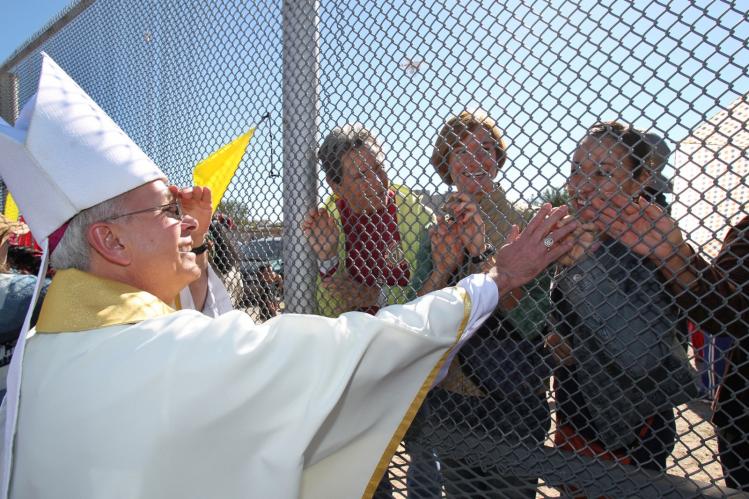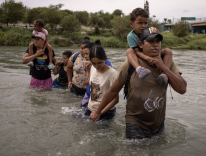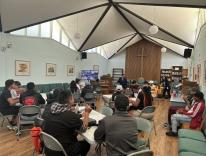
As President Trump continues to demand billions for what he calls a “beautiful” border wall, a Catholic bishop from the United States–Mexico border and other immigration-reform advocates visited Washington, D.C. earlier this week to challenge what they described as persistent myths that lead to immoral and ineffective immigration policies.
“Please hear the stories of immigrants,” Bishop Mark Seitz of El Paso, Texas told about seventy-five congressional staff members during a briefing on Capitol Hill. “Don’t let the political morass in Washington take you over. Stand for something. Listen to your conscience.” At the briefing, the El-Paso based Hope Border Institute released a new report—“Sealing the Border: Criminalization of Asylum Seekers in the Trump Era”—that details human-rights violations by immigration-enforcement agencies against migrants and asylum seekers.
“An analysis of nearly 300 documented cases revealed that the Trump administration has looked to El Paso as a laboratory for its brutal model of immigration and border enforcement,” according to the thirty-eight-page report. “By effectively nationalizing troubling policies, practices, patterns and a culture of abuse unique to the El Paso Sector, the Trump administration has weaponized border enforcement, immigrant detention and the immigration courts, solidifying an iron triangle of deterrence against bona fide asylum seekers, forcing them to make the painful choice between deportation and prolonged detention.”
Dylan Corbett, the executive director of the Hope Border Institute and a former staffer at the U.S. Conference of Catholic Bishops, explained that the militarization of the border has come at both a human and fiscal cost. President Trump’s insistence on more fencing on the border to stop crime and violence, he said, is a solution in search of the problem. According to FBI data, El Paso and other border communities have been ranked as some of the safest cities in the country.
“The wall is not addressing an actual policy problem,” Corbett said. “It’s political theater.” While border fencing is usually talked about as a simple security issue, the reality is more complicated. The original wall in El Paso, constructed in the 1990s between El Paso and Ciudad Juarez, Mexico, was built at the same time as the North American Free Trade Agreement (NAFTA), which became a boon to U.S. corporations even as hundreds of thousands of factory workers just across the border in Mexico earn an average of $50 a week. “The motivations for putting up that wall are economic,” Corbett said. “It ensures the flow of capital, but poor people, brown people, can’t travel freely. We are morally complicit in many of the root causes that drive migration—free trade deals, our drug consumption. We are involved. To build a wall is to close our eyes to our ethical responsibilities.”
More border fencing would also be a waste of resources and fail to address the problems that proponents claim it would solve, according to Kevin Appleby, the senior director of international migration policy at the Center for Migration Studies. Those who argue that waves of undocumented immigrants are coming over the border perpetuate a myth that leads to distorted policy responses. The number of undocumented Mexicans coming to the United States, Appleby noted, has fallen by one million from 2010 to 2016, and net migration is down 11 percent over the last five years. Over the last decade, in fact, 600,000 more immigrants in the United States became undocumented because they overstayed the time allotted on their legal visas than because they illegally crossed the border. “A border wall would address the wrong trend,” Appleby, a former staffer at the U.S. bishops’ conference, said.
There is also a profound humanitarian cost to increased border fencing. Since 2008, immigrant deaths in the desert have increased by 20 percent as militarization of the border drove desperate immigrants to find more dangerous routes. Along with the cost in lives, the financial expense of continuing to beef up border security are questionable on a practical level. The United States spends $19 billion a year on the Department of Homeland Security’s two immigration agencies—Immigration and Customs Enforcement (ICE) and Customs and Border Protection. This amount currently exceeds the combined budgets of all other U.S. federal law enforcement agencies, and would rise to $24 billion under the Trump administration’s 2018 budget. Appleby and other immigration-policy analysts argue this ballooning figure is money not efficiently spent. “It is fair to ask whether the nation could spend more of its enforcement dollars more effectively on addressing the conditions that drive migration,” his organization notes on its web site.
Linda Rivas, an attorney who represents detained immigrants for the Borderland Immigration Council, told the congressional staffers that the Trump administration's policy toward migrants and asylum seekers is separating parents from children. Because of “arbitrary transfers”—sending an immigrant to a detention center far from their home and often thousands of miles from their detained children—family separation, Rivas noted, is becoming more common and systemic. “When I started this work five years ago I would tell my clients that we're going to fight your case and they would tell me they feel safe,” Rivas said. “Now there is complete desperation. Enforcement practices on the border degrade our morals, our values and fundamentals of due process.”
Catholic leaders will continue to insist that every human being bears the image of God and should be treated with dignity. But along with following the Gospel, the church’s stand for immigrants is also rooted in lived experience on the ground, and well-documented research provided by organizations like the Hope Border Institute. President Trump can have his tweets, and his addiction to fantastical propaganda from Fox News pundits. Moral clarity and facts are on our side.
Please email comments to [email protected] and join the conversation on our Facebook page.
Share
Previous Story
Poem | Good Friday Migraine
Next Story
Populism Isn’t the Villain

